ACER investigates biodiversity’s role in oil spill recovery
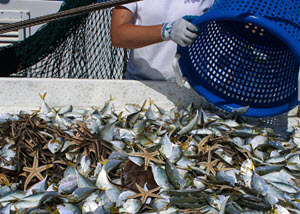
Marine animals caught during the Spring 2015 trawling cruise near the Chandeleur Islands. Atlantic Bumper dominated this haul but Lined Sea Stars were also caught as well as a Lesser Electric Ray (bottom center). (Photo courtesy of ACER)
Disturbances to coastal environments, such as storms and pollution, cause great concern as these areas are typically heavily populated, are home to important industries, and provide critical ecosystem services. Ecologists have debated coastal ecosystems response to disturbances for decades.
The Deepwater Horizon oil spill focused this debate on the Gulf of Mexico, where beliefs ranged from the ecosystem being irreparably damaged to nothing significantly negative happened. It is more likely that there is a third alternative – recovery in some areas and not in others – that can be explained by the marine species present.
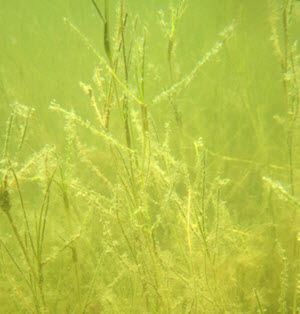
Four species of submerged aquatic vegetation provide important habitat for juvenile organisms and can be found in the calm shallow waters on the western side of the Chandeleur Islands. This photo of widgeon grass (Ruppia maritima) was taken during a sampling expedition to the Chandeleur Islands, May 2015. (Photo courtesy of ACER)
Scientists with the Alabama Center for Ecological Resilience, or ACER, are working to improve our understanding about biodiversity’s role in regulating coastal ecosystems’ productivity and resilience. ACER recently completed the first year of a multi-year Gulf of Mexico Research Initiative grant. Consortium director John Valentine, the Executive Director for the Alabama Dauphin Island Sea Lab and marine scientist, shared some thoughts about their work and how it should provide key insights for interpreting the impacts of this and future spills:
We theorize that variances in the oil spill impacts were influenced by local biodiversity. Some species may have been very susceptible to the oil and perhaps died, while others might not and could replace those that were lost. Is recovery the sum of all species response, or are there a few strong species that make recovery possible? The answer lies in understanding how marine ecosystems function.
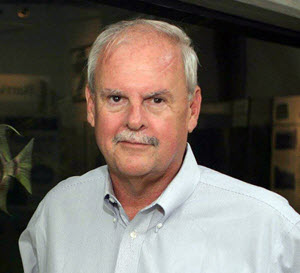
Dr. John Valentine, the ACER consortium director and the Executive Director for the Alabama Dauphin Island Sea Lab. (Photo courtesy of ACER)
Valentine said that the realized effects of a spill, such as biomass and productivity losses or gains, may be dependent on inhabitants’ diversity. The team’s goal is to differentiate among coastal ecosystems relative to their susceptibility to oil damage and inform damage assessment and response with knowledge about which communities are likely to rebound. However, the science about impacts from reduced biological diversity and subsequent indirect effects that cascade through food webs when biodiversity changes, is lacking. Valentine explained that their research team will address these information gaps:
The oil spill highlighted how little we know about how marine organisms at various life stages or trophic positions respond to oil exposure and its associated contaminants. A better understanding of oil spill effects on biodiversity at the genetic, taxonomic, and functional levels can help improve management, recovery and restoration plans following future environmental disasters.
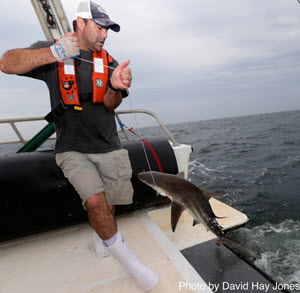
Dr. Marcus Drymon brings in a shark during a bottom longline cruise to sample large predators offshore of the Chandeleur Islands, April 2015. (Photo by David Hay Jones, courtesy of ACER)
The ACER project scope is broad, covering marine flora and fauna from microbes to sharks. Valentine expects that ACER research will have a very high level of “realism” because scientists will draw conclusions from most living aspects of the northern Gulf, providing a more holistic marine ecosystem understanding as opposed to extrapolating from a single group of organisms or a single ecosystem. He explained why impacts from disturbances can be difficult to predict without a deep understanding of the role biological diversity plays in determining the resilience of marine ecosystems:
Man-made and natural disturbances do not occur in isolation, and their impacts can vary temporally and spatially. These disturbances can alter ecosystem structure, causing species losses or additions. When such changes occur, the functions of impacted ecosystems also change in ways that may not be reversible, especially when the key capabilities of lost species are not replaced by newly gained species. Conversely, if newly gained species possess novel genetic variability, they can transform ecosystem function in unexpected ways.
Valentine gave a more specific example to explain the need for studying marine species and their genetics in a broad ecosystem context:
Smaller or lower-level food web organisms with little mobility may experience more damage than the higher-level, mobile organisms like sharks and big fish. However, small species with high genetic diversity may have a broad range of responses to disturbances and have a better chance of surviving than large species with relatively low genetic diversity. Understanding an area’s genetic and species diversity can greatly inform predictions about long-term ecosystem risks from disturbances.
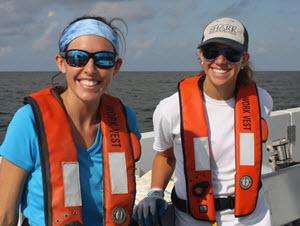
ACER graduate students Emily Seurbert and Laura Stone onboard a research vessel trawling for marine samples. (Photo courtesy of ACER)
Seven science teams are focusing on aspects of biodiversity for different ecosystem components or processes: nitrogen cycling, microbes, microplankton, macroinfauna, marshes and mangroves, oyster reefs, and higher order consumers. The teams will combine their work to provide a bigger-picture analysis of ecosystem structure (density, biomass, and biodiversity) and processes (productivity, nutrient cycling, and predation) and services (habitat provisioning and shoreline stabilization) across a gradient of heavily-oiled to unoiled conditions at the Chandeleur Islands. Then they will determine how the genetic, taxonomic, and functional biodiversity of coastal ecosystems influenced ecosystem responses to oiling. ACER teams completed two major and several smaller field expeditions during the past year and analysis is underway for samples collected, including gene sequencing.
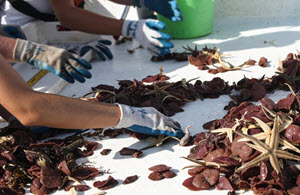
Researchers found Sea Pansies and Lined Sea Stars when trawling offshore of the Chandeleur Islands during the Spring 2015 survey. This survey will help document mid and higher level consumer diversity and abundance across the northern Gulf of Mexico. (Photo courtesy of ACER)
The teams are supplementing field work with controlled mesocosm studies to get at what Valentine described as “the tipping point” or the level of disturbance that overwhelms an ecosystem’s ability to recover. Using different oil and oil-dispersant concentrations, researchers will observe the communities’ response and compare measurements with experimental controls as well as historical pre-spill datasets and data on fish populations collected by Dauphin Island Sea Lab researchers during the oil spill. Valentine explained the role of these mesocosm studies:
Manipulations of oil and oil-dispersants mixtures in scenario-based mesocosm experiments will improve our understanding of how key ecosystem attributes determine oil spill impacts. This knowledge will help our investigators make data-driven recommendations to local, state, and federal officials and inform their decisions on future response and restoration actions.
ACER’s Education and Outreach Team is working with the Mobile County Public School System to share their science with students and teachers through curriculum development and project-based learning activities. One planned activity is to have high school students build and track GPS-enabled drifters that they drop in a number of state watersheds that feed into Mobile Bay. Students will use social media to communicate with their state legislators, illustrating the connectivity of inland waters and the Gulf and, by extension, how these waters may have influenced how oil impacted Mobile Bay.

Dr. Kenneth Heck looks over the Chandeleur Island shoreline in May 2015 to verify sampling locations. (Photo courtesy of ACER)
The ACER education specialists are also working collaboratively with Alabama middle and high school teachers to develop standards-based science lesson plans that fill identified needs with a focus on helping students understand the scientific process. As part of a formative evaluation, the teachers will use these plans and provide feedback for improvement. Lesson plans will ultimately be available to a larger pool of teachers through ACER’s website and lesson plan websites. The team will also develop exhibitry on project results for DISL’s public aquarium, The Estuarium, and conduct a series of public lectures on ACER science.
The ACER consortium includes the Dauphin Island Sea Lab (lead institution), Florida Gulf Coast University, Louisiana State University, Northeastern University, Rutgers University, Siena College, the University of Alabama, the University of North Carolina at Chapel Hill, the University of South Alabama, and the University of South Florida.
For more information about the ACER program and people involved, click here and visit the ACER website.
************
The Gulf of Mexico Research Initiative (GoMRI) is a 10-year independent research program established to study the effect, and the potential associated impact, of hydrocarbon releases on the environment and public health, as well as to develop improved spill mitigation, oil detection, characterization and remediation technologies. An independent and academic 20-member Research Board makes the funding and research direction decisions to ensure the intellectual quality, effectiveness and academic independence of the GoMRI research. All research data, findings and publications will be made publicly available. The program was established through a $500 million financial commitment from BP. For more information, visit http://gulfresearchinitiative.org/.
